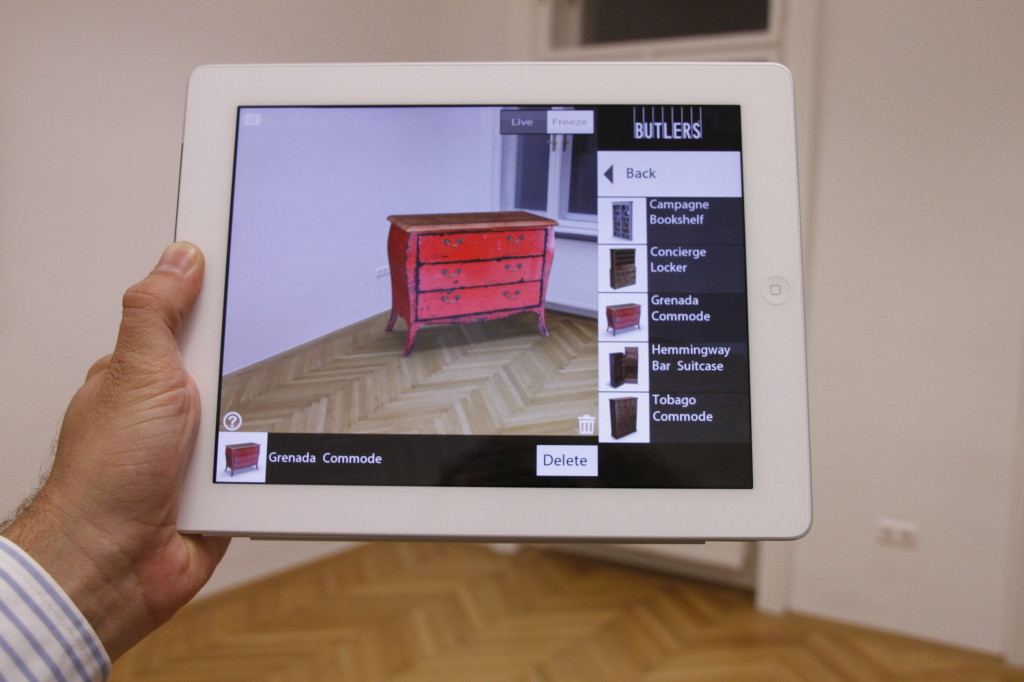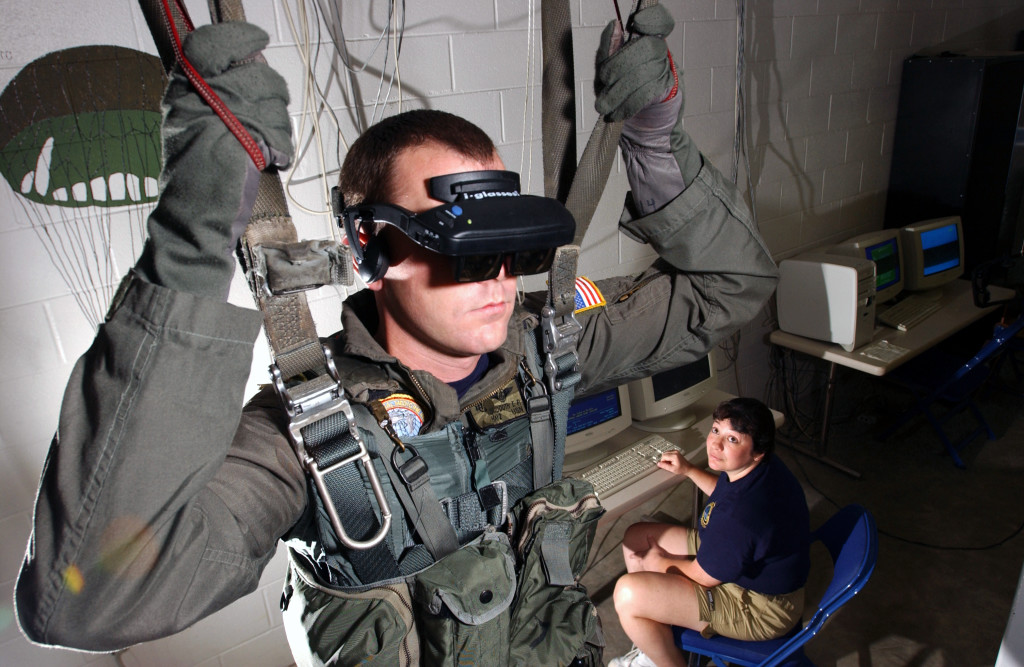-

-

-

-

-

-

-

-

-

-

-
-

-

-

-

-

-

-

-

-

-

-

-

-

-

-

-

-

-

-

-

-

-

-

-

-

-

-

-

-

-

-
-

-

-
 TOTW: Google's Project Ara Modular Phone May Be The Future Of SmartphonesOctober 30, 2014
TOTW: Google's Project Ara Modular Phone May Be The Future Of SmartphonesOctober 30, 2014 -

-

-

-

-

-

-

-

-

-

-

-

-

-

-
-
-

-

-

-

-

-

-

-

-

Posts tagged Microsoft HoloLens
Augmented Vs. Virtual Part 2 – Augmented Reality
09 years
Reality is very personalized, it is how we perceive the world around us, and it shapes our existence. And while individual experiences vary widely, for as long as humans have existed, the nature of our realities have been broadly relatable from person to person. My reality is, for the most part, at least explainable in terms of your reality. Yet as technology grows better and more widespread, we are coming closer to an era where my reality, at least for a period of time, may be completely inexplicable in the terms of your reality. There are two main ways to do this: virtual reality and augmented reality. In virtual reality, technology immerses you in a different, separate world. My earlier article on VR was the first of this two-part series, and can be found HERE.
Whereas virtual reality aims to totally replace our reality in a new vision, augmented reality does what the name suggests: it augments, changes, or adds on to our current, natural reality. This can be done in a wide variety of ways, the most popular currently being a close-to-eye translucent screen with projected graphics on top of what you are seeing. This screen can take up your whole field of view, or just in the corner of your vision. Usually, the graphics or words displayed on the screen is not completely opaque, since it would then be blocking your view of your real reality. Augmented reality is intrinsically designed to work in tandem with your current reality, while VR dispenses it in favor of a new one.
With this more conservative approach, augmented reality (AR) likely has greater near-term potential. For VR, creating a new world to inhabit limits many of your possibilities to the realm of entertainment and education. AR, however, has a practically unlimited range of use cases, from gaming to IT to cooking to, well, pretty much any activity. Augmented reality is not limited to, but for now works best as a portable heads-up display, a display that shows helpful situational information. For instance, there was a demo at Epson’s booth at Augmented World Expo 2015 where you got to experience a driving assistance app for AR. In my opinion, the hardware held back the software in that case, as the small field of view was distracting and the glasses were bulky, but you could tell the idea has some potential. At AWE, industrial use cases as well as consumer use cases were also prominently displayed, which included instructional IT assistance, such as remotely assisted repair (e.g., in a power plant, using remote visuals and audio to help fix a broken part).
Before I go on, I have to mention one product: Google Glass. No AR article is complete without mentioning the Google product, the first AR product to make a splash in the popular media. Yet not long after Google Glass was released, it started faded out of the public’s eye. Obvious reasons included the high price, the very odd look, and the social novelty: people couldn’t think of ways they would use it. Plus, with the many legal and trust issues that went along with using the device, it often just didn’t seem worth the trouble. Yet rumor has it that Google is working on a new, upgraded version of the device, and it may make a comeback, but in my opinion it’s too socially intrusive and new to gain significant near-term social traction.
Although many new AR headsets are in the works (most importantly Microsoft’s HoloLens), the development pace is lagging VR, which is already to the stage where developers are focused on enhancing current design models, as I discussed in the previous VR article. For AR, the situation is slightly different. Hardware developers still have to figure out how to create a cheap AR headset, but a headset that also has a full field of view, is relatively small, doesn’t obstruct your view when not in use, and other complications like that. In other words, the hardware of AR occasionally interrupts the consumption of AR content, while for VR hardware, the technology is well on its way to overcoming that particular obstacle.
Beyond these near-term obstacles, if we want to get really speculative, there could be a time when VR will surpass AR even in pure utility. This could occur when we are able to create a whole world, or many worlds, to be experienced in VR, and we decide that we like these worlds better. When the immersion becomes advanced enough to pass for reality, that’s when we will abandon AR, or at least over time use it less and less. Science fiction has pondered this idea, and from what I’ve read, most stories go along the lines of people just spending most of their time in the virtual world and sidelining reality. The possibilities are endless in a world made completely from the fabric of our imagination, whereas in our current reality we have a lot of restrictions to what we can do and achieve. Most likely, this will be in a long, long time, so we have nothing to worry about for now.
Altogether, augmented reality and virtual reality both are innovative and exciting technologies and that have tremendous potential to be useful. On one side, AR will be most likely used more than VR in the coming years for practical purposes, since it’s grounded in reality. On the other hand, VR will be mostly used for entertainment, until we hit a situation like what I mentioned above. It’s hard to pit these two technologies against each other, since they both have their pros and cons, and it really just depends on which tech sounds most exciting to you. Nonetheless, both AR and VR are worth lots of attention and hype, as they will both surely change our world forever, for better or worse.
Augmented vs. Virtual Part 1 – Virtual Reality
19 years
Technologically enhanced vision has been with us for many hundreds of years, with eyeglasses having been in use since at least the 14th century. Without effective sight, living has of course remained possible during this era, but it is a meaningful disadvantage. Now, new technologies are offering the promise to not only make our lives easier, but to also give us new capabilities that we never thought possible.
This idea, enhancing our vision using technology, encompasses a range of technologies, including the two promising arena of augmented reality (AR) and virtual reality (VR). The names are fairly self-explanatory; augmented reality supplements and enhances your visual reality, while virtual reality by contrast creates a whole new reality that you can explore independently of the physical world. Technically, AR hardware generally consists of a pair of glasses, or see-through panes of glass attached to hardware, which runs software that projects translucent content onto the glass in front of you. VR, on the other hand, is almost always a shoebox/goggle-like headset, with two lenses allowing two different screens in front of your eyes to blend into one, using head motion-tracking to make you feel like you are in the virtual world. Both are very cool to experience, as I experienced while attending the Augmented World Expo last week in Silicon Valley, where I have able to demo a host of AR and VR products. This article focuses on my experiences with Virtual Reality gear; next week I will follow-up with thoughts on Augmented Realty.
Virtual Reality
Virtual reality, when combined with well-calibrated head-tracking technology, allows you to be transported into a whole new world. You can turn your head, look around, and the software responds as if this world is actually around you, mimicking real life. This world can be interactive, or it can be a sit-back-and-relax type experience. Both are equally astounding to experience, as the technology is advanced enough so that you can temporarily leave this world and enter whatever world is being shown on your head mounted display (HMD). I wrote about a great use-case of VR at the AWE Expo recently, which involved being suspended horizontally and strapped into a flight-simulation VR game.
Despite what you might think, the optics no longer seem to be a problem, as the engineers at early leaders including Oculus and Gear VR have designed headsets that don’t bother our eyes during use, a problem that plagued early models. That said, complaints persist about vertigo and eye-strain from long periods of use. Even Brendan Iribe, Oculus CEO, got motion sickness from their first Dev kit. Luckily, but his company and others have been making improvements to the software. Personally, I didn’t get sick the least bit while at the conference.
Uses for VR, among many, tend to fall in one major category thus far: entertainment. Video games are set to be transformed by virtual reality, which promises to bring a new dimension into what could be possible in a gaming experience. First-person shooters and games of that like were already trying to become as real and immersive as possible on a flat screen, but with a 360-degree view around the player, and interactive head-tracking… well, it’s surprising that games like Halo, Destiny and Call Of Duty don’t already have VR adaptations. And games with a more artistic themes and play will also benefit greatly in using VR rather than 2D screens, as adding the ability to look around and feel like you are in the game will surely spark ideas in many developer’s heads. At E3 2015, which took place this week in Los Angeles, many commented that virtual reality was an obvious trend in gaming this year, and excitement was starting to build about VR’s potential in gaming. While hardly a gaming exclusive environment, VR appears to be a promising tool for immersive military training as well. Nothing prepares a soldier or a pilot better for an on the battlefield or in the air situation better than already pseudo-experiencing it. The possibilities for gaming and military training are endless in terms of VR, and it really is exciting to see what developers are coming up with.
One thing that may hold VR back is the hardware. Despite having mitigated the vertigo issues, another hardware complaint has been weight. While the Oculus Dev Kit 2 is a little less than 1 pound, which isn’t much, but can be strenuous when wearing for a long period of time. Still, if we have learned anything from the growth of smartphones it’s that technology marches in one clear direction: smaller, lighter, and faster. And that’s one thing that I believe separates AR and VR: VR is already to the point that the only changes needed to be made will be upgrades to the existing hardware. The pixel density, the graphics speed, the weight, the size. Not to mention that in a few years, many of the major problems with VR will be solved, and this is something that I think separates it from AR.
Whereas all VR has to do is get the hardware right and then integrate head tracking software into their 3D games or movies, AR has a ways to go until has perfected its hardware to the same level as VR has. AR is frankly just harder for the developers. Not only do they have to worry about the pixel density, head-tracking, weight, and size like VR, but they have to worry about depth, the screen transparency, object recognition, 3D mapping, and much more. Currently, there isn’t one big AR player, like Oculus, that small developer teams can use as a platform for their own AR software, and that might also be limiting the growth of the technology. A big player may emerge in the next could years, with candidates including Google Glass and Microsoft’s upcoming AR headset HoloLens leading the race, but for now, AR isn’t really an area where small developing teams can just jump in.
In the grand scheme of things, AR and VR are at similar stages of development. Within a decade or two, these problems will vanish, and the technologies will be face-to-face, the only thing separating them is their inherent utility in particular situations. For VR, it is a technology that was made for entertainment and gaming. The idea of transporting yourself to another world, especially when the tech is fully developed and you can’t tell the difference between VR and real life, is as exciting as it is terrifying. Still, we can’t help but try to create these amazing games and experiences, as they very well may expand humanity into virtual world we never could have dreamed of. As developers start meddling with the technology, and consumers start buying units, VR will grow into many more markets, but for now, entertainment, gaming, and military training are the main uses. It really is a technology out of the future, and I can’t wait to see what amazing experiences and tools that VR will bring to the world next.
This is the first piece in a two-part series on AR vs. VR. Check back here soon for the second article!



